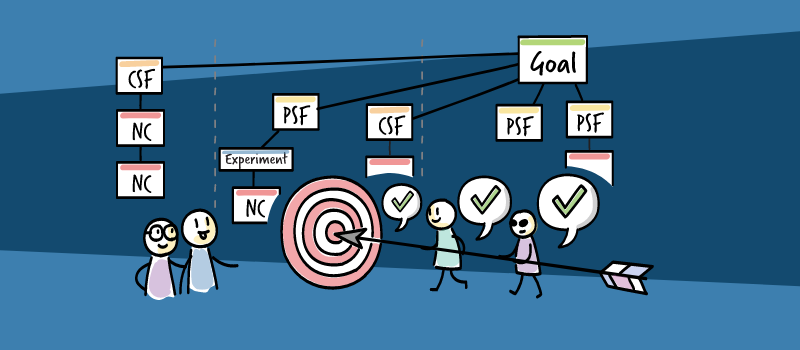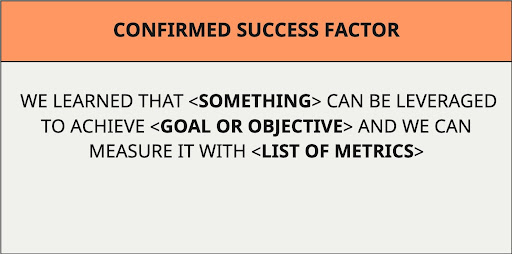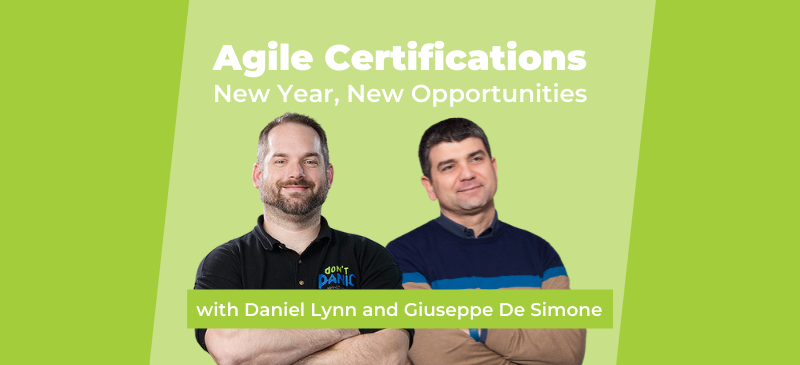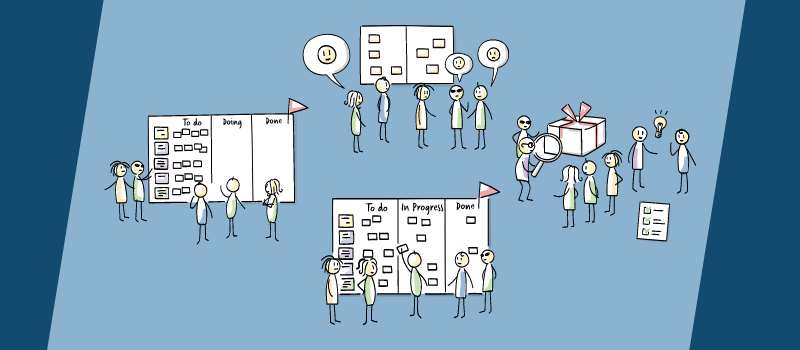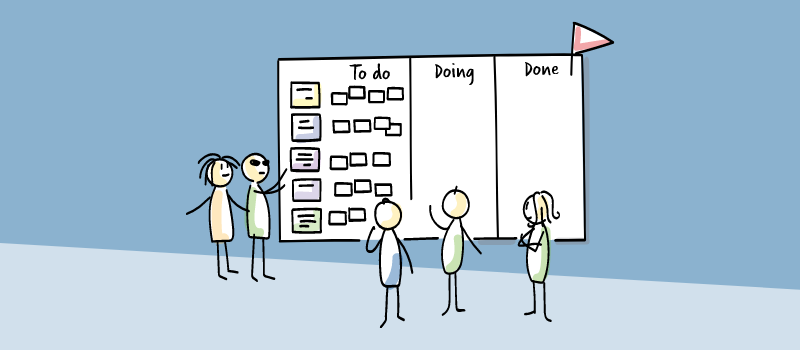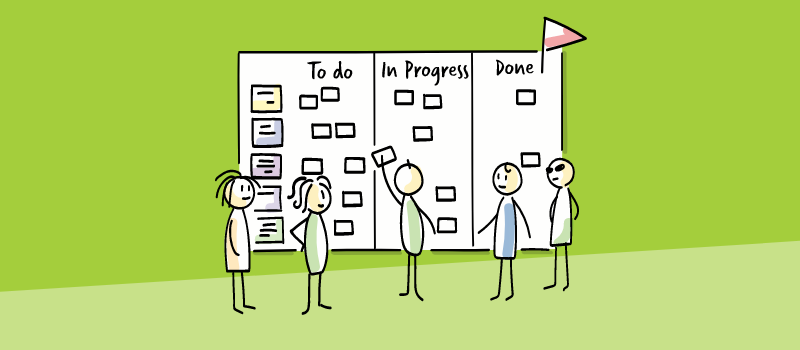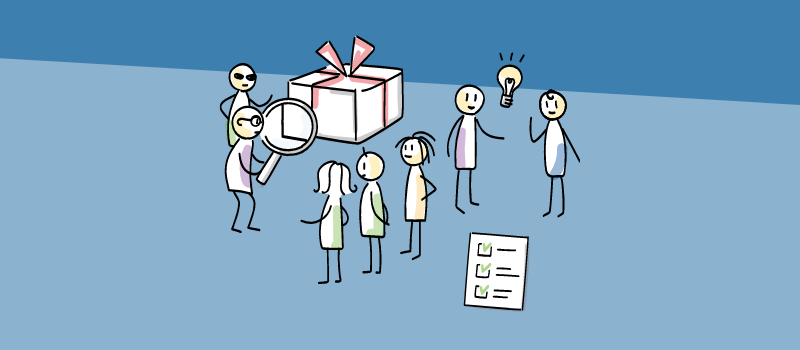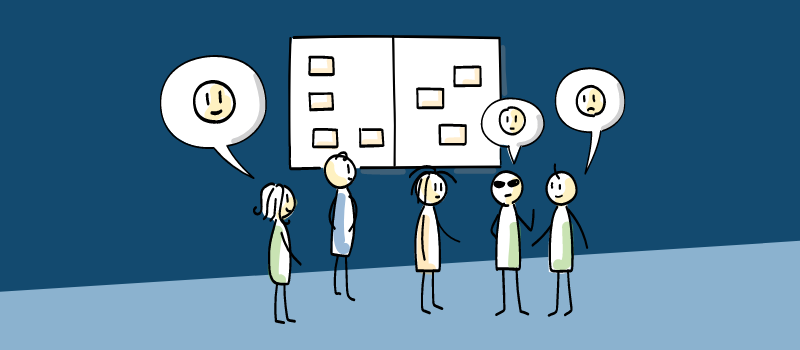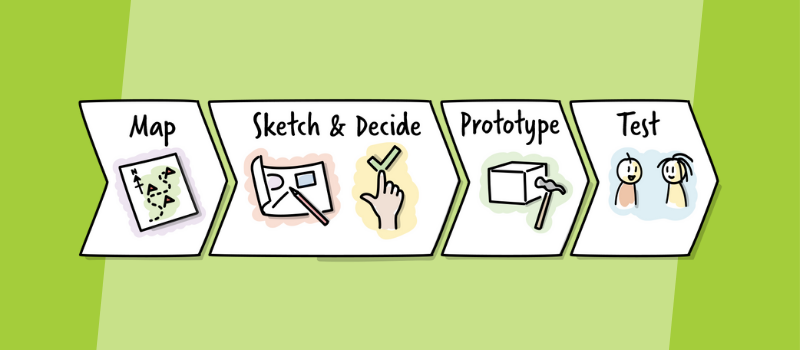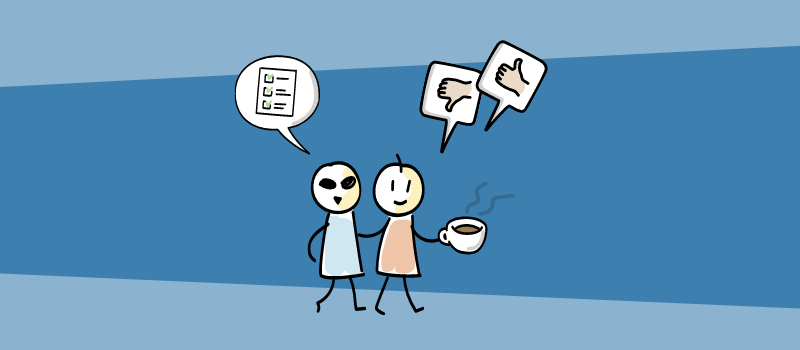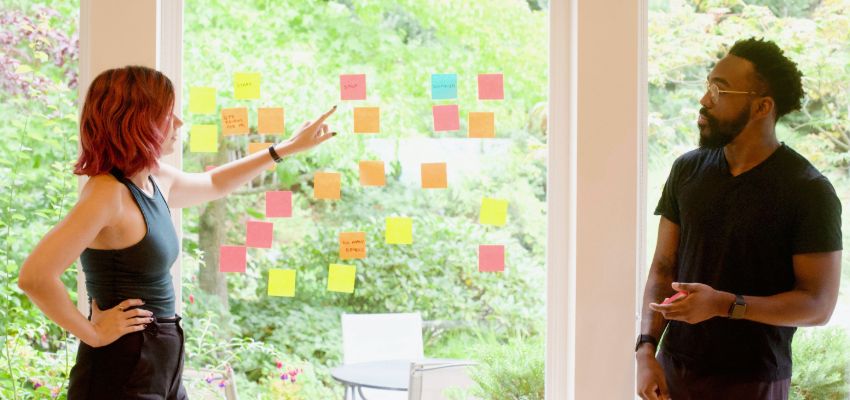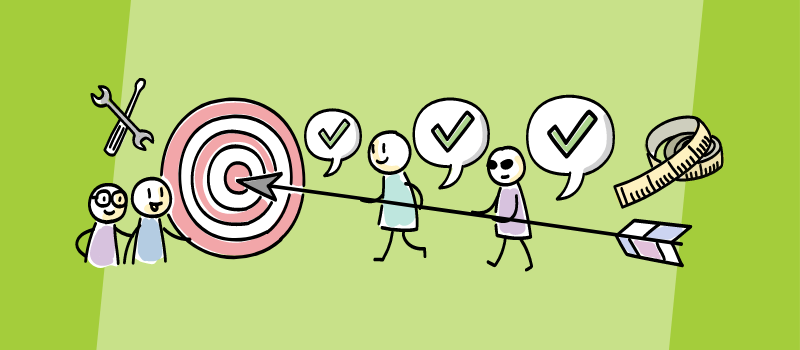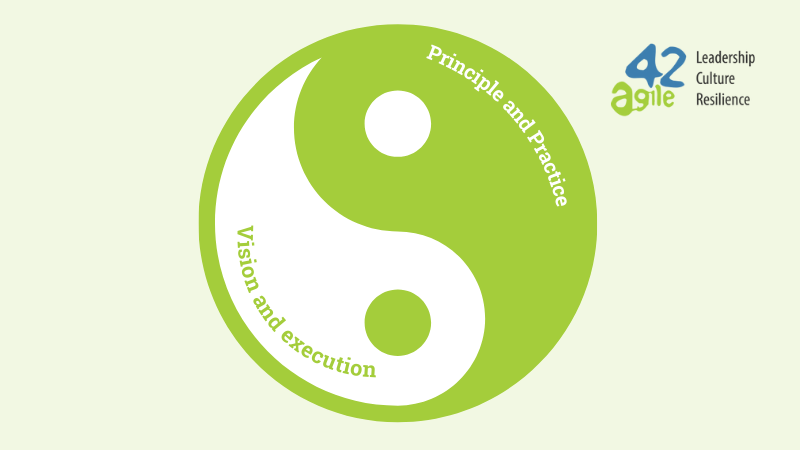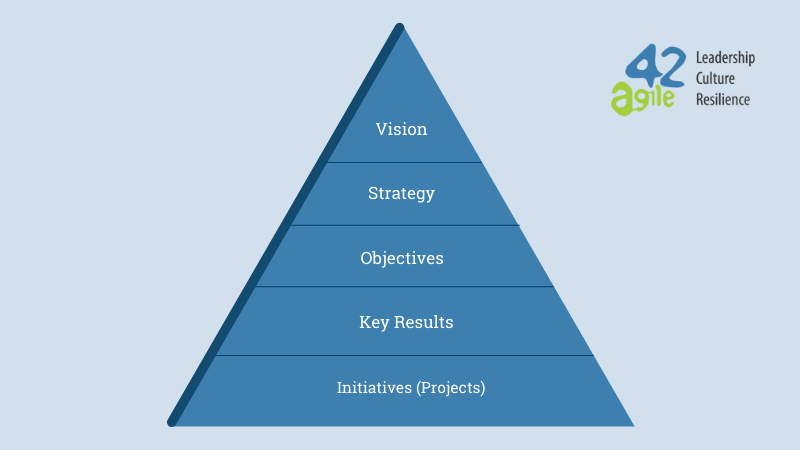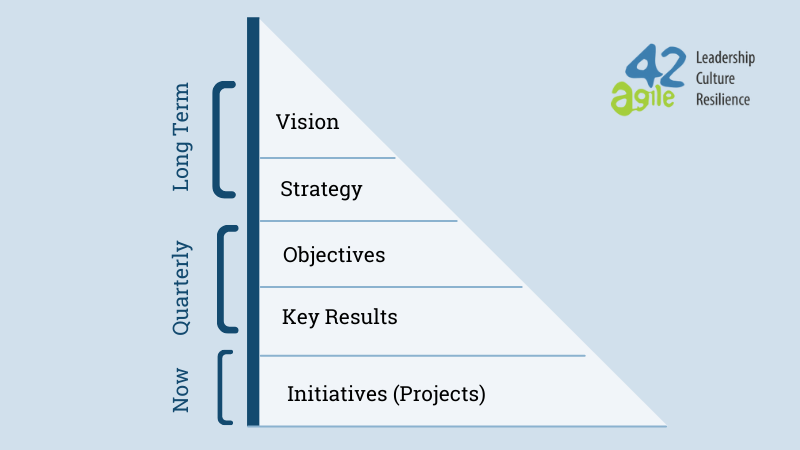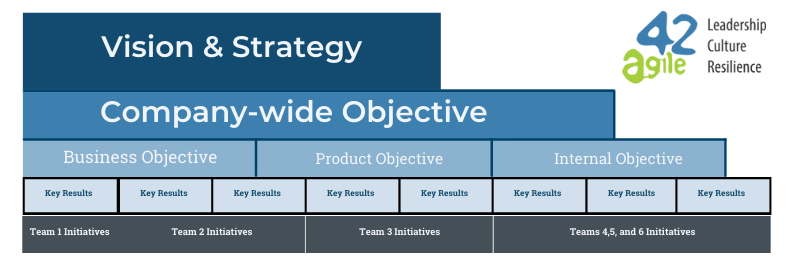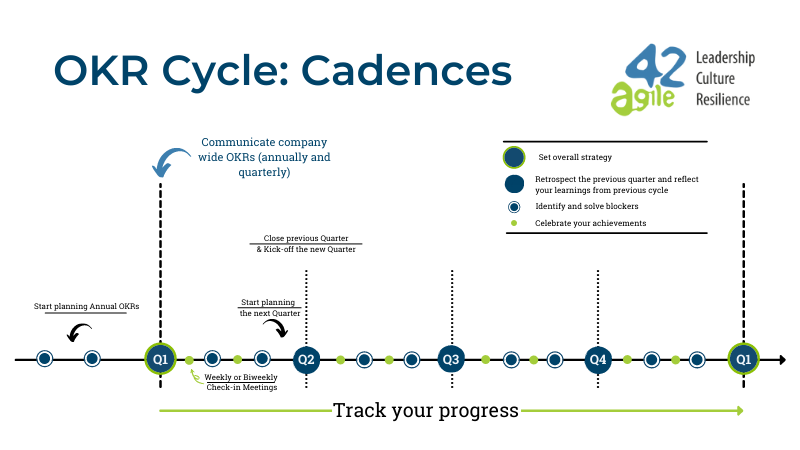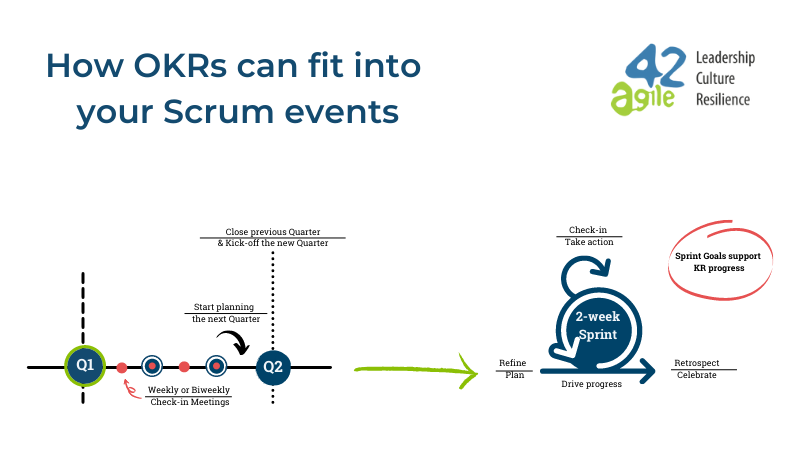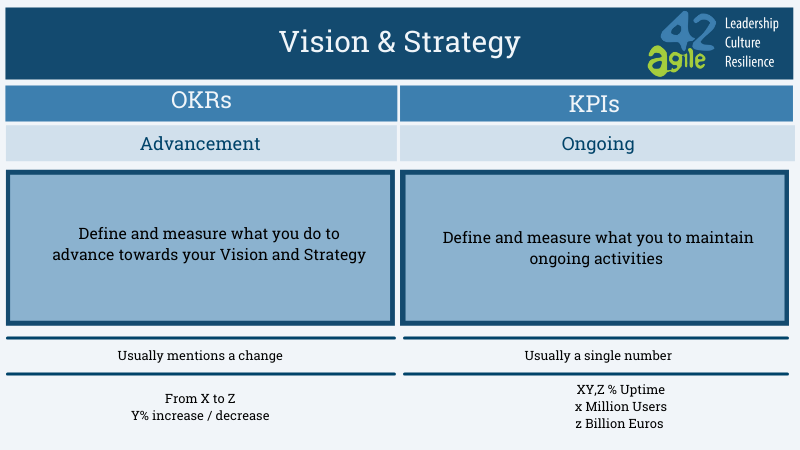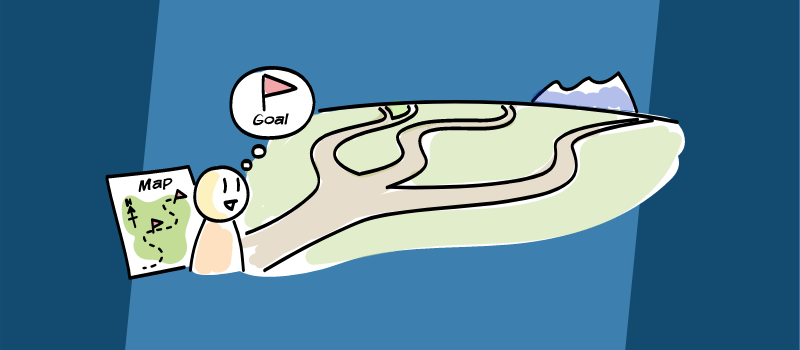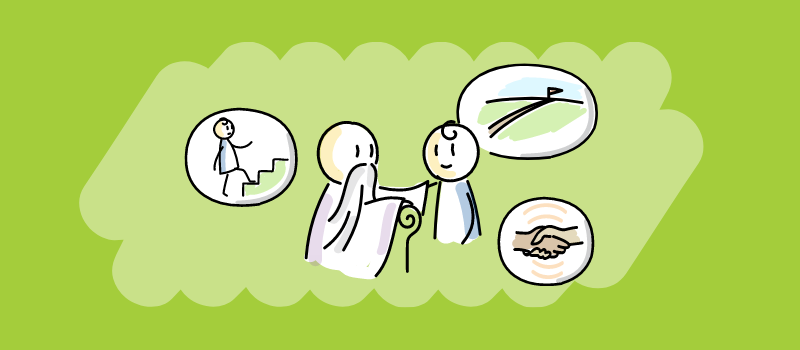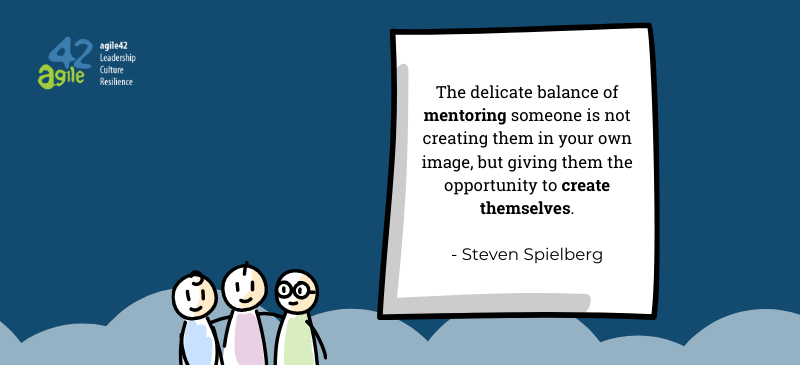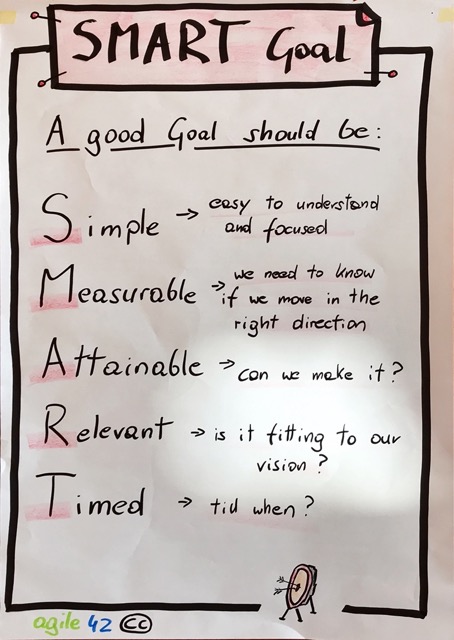Combine your OKRs with Agile Strategy Map™ for Success
OKRs are one of the most widely used goal-setting frameworks, defined by a set of Objectives and Key Results, which each employee in an organization works towards. The Agile Strategy Map™ is a collaborative framework developed by agile42 that helps organizations design, manage, execute, and support their strategy.
In this blog post, I’ll bring you an alternative look at the Agile Strategy Map™ and how organizations can combine it with the OKR approach to planning, with the ultimate result of more realistic goals.
What is The Agile Strategy Map™?
The Agile Strategy Map™ is a way to design a company strategy in a transparent and incremental way, based on continuous experimentation and adaptation. It makes this strategy available to everyone in the organization. The framework also provides a solid operating model that allows you to break down identified success factors into workable items, in a collaborative and agile way. agile42 has developed this framework through real-life experiences with clients and the help of many coaches who contributed over time to refine and improve its usability. The Agile Strategy Map™ can be a stand-alone tool for an organization, or it can be used in the context of an approach inspired by the principles of ORGANIC Agility. In this case, it corresponds to the basic principle of validating changes in small increments.
What are OKRs?
OKR (or OKRs) stands for Objectives and Key Results, and it is a framework for setting a company, team, or individual’s goals. The value of OKRs is that they create transparency around the organization’s goals, which in turn helps employees feel more aligned and committed to achieving those goals.
Further reading: A Complete Guide to OKRs
The overlap between OKRs and The Agile Strategy Map™
OKRs and Agile Strategy Map share two crucial principles that contribute to success:
- Change (and delivery) in small and frequent increments
- Engaging people actively in the process of change (and delivery)
Along with those principles, there are also a few other common elements:
- Both spotlight focus
- They combine bottom-up and top-down approaches
- They have regular cadences
- Each has roles
Advantages of The Agile Strategy Map™
The Agile Strategy Map™ will help you build more realistic KRs, experiment in a safe-to-fail way, and avoid flying blindly. There are a number of advantages to combining the two frameworks, rather than simply using OKRs alone.
The Agile Strategy Map™ can distinguish the different types of KRs more clearly
I have been involved in many different companies’ OKR plans over the course of my career. I observed that the teams were usually struggling to name the correct “target” for their Key Results. Most of the time, people use common sense or draw from previous experiences or market benchmarks. The challenge is to strike a balance between ambition and achievability. The OKR framework uses different types of Key Results, including “Learning, Committed and Aspirational.” However, in reality, I’ve mostly encountered Key Results for “Committed” and “Aspirational” types; I rarely see “Learning” KRs.
The Agile Strategy Map™ uses Success Factors
To indicate how you will accomplish your Goal, The Agile Strategy Map™ uses Success Factors. Depending on the organization’s prior knowledge level about the goal, these will be either Confirmed or Potential Success Factors. Distinguishing the “possibility” from “plausibility” will decrease your risk and improve the success of your decisions.
The Cynefin Framework presents the basis of this approach. Cynefin provides a way to make sense of the context we are in by observing patterns and constraints. It also provides guidance about the most appropriate way to act.
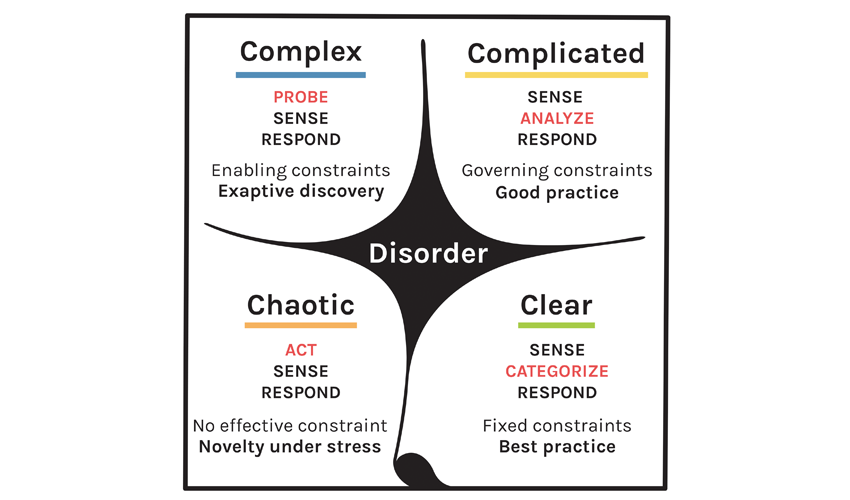
After analyzing our path towards the targets, if we don’t recognize patterns, best or good practices, governing or rigid constraints, most probably we are finding ourselves in an “Unordered Domain.” In that case, we have to be empirical, maybe design a few experiments to probe the environment in the hope to identify emergent practices. All the Key Results (or Success Factors) we see are the “Potential Success Factors” and we need to validate these at some level.
The Agile Strategy Map™ allows you to see your journey more clearly
The Agile Strategy Map™ collects and shows all learnings, failures, and decision points. As Spanish philosopher George Santayana said, “Those who don’t remember the past are condemned to repeat it.”
The Agile Strategy Map™ follows the insights and theory provided by Wardley maps, named after Simon Wardley. Wardley combined the thinking of OODA loops (the decision-making cycle of observe, orient, decide, and act) from military strategist John Boyd and The Art of War from Chinese general Sun Tzu to create a basic cycle for thinking about strategy. According to Wardley’s Map, good strategy tools shall be visual, context-specific, positional, and display connections. It helps us navigate the plan, anchoring us by reference a direction and suggesting a movement and/or changes, where we are going, and where we have been.
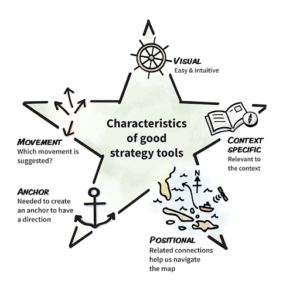
The Agile Strategy Map™ allows you to iterate and improve on OKRs
OKRs are usually followed for a certain period, and when they are done, they are done. It’s possible to re-iterate the Key Results and make them more ambitious, but they don’t show you the journey and what you have learned along the way. Although OKRs are visual, context-specific, positional, and have anchors, they lack movement. They are static. They don’t suggest changes based on where you have been. This can make it difficult to recognize and respond to the signals that are hinting towards direction changes, potentially invalidating the relevance of the defined Targets/Objectives. The Agile Strategy Map™ allows you to constantly introduce new Potential Success Factors (PSFs) as they appear, and quickly relate them to the existing map, and identify dependencies and impacts very quickly.
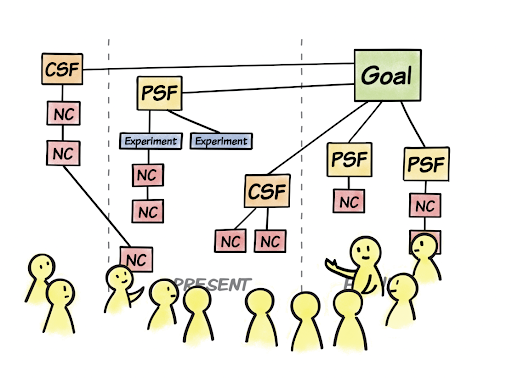
How to combine OKRs and Agile Strategy Map™
It’s possible to combine the OKR framework to achieve the above-mentioned advantages. Here is an outline of how to do this effectively.
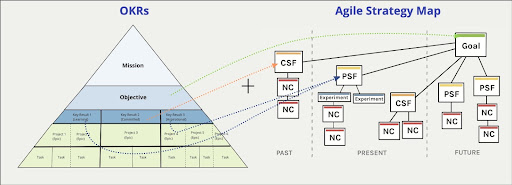
Step 1: Create your OKR pyramid
Define an inspirational goal for yourself and/or your team and then divide that into smaller, reachable, quarterly objectives. Then, define the Key Results that will help you reach your objective. Next, plot the tasks and projects that will result in achieving the defined Key Results.
Step 2: Reframe your Objective as your “Strategic Goal”
Ensure that your Goal has clearly defined “desired outcomes” which are measurable and connected to creating value for users, customers, and/or employees. They should also give direction.
Step 3: Refine your Key Results and decide if they are “Confirmed” or “Potential” Success Factors
Confirmed Success Factors (CSFs)
Confirmed Success Factors (CSFs) are based on past learnings or proven practices and they might be in the form of processes, rules, policies, constraints, approaches. In short, they include everything that works within the organization, and has an established value proposition for customers. Given the defined Goal, we may identify a subset of CSFs that will be enablers for achieving that Goal. These are our “Committed Key Results.” The fact that they are confirmed tells us that they are Learned, and the fact that we choose them as relevant for achieving our goals makes them Committed.
A Confirmed Success Factor may be expressed in the following form:
Potential Success Factors (PSFs)
Potential Success Factors (PSFs) are hypotheses that we believe might help us to achieve our goal. These hypotheses need to be made explicit so that through transparency, dependencies can be made visible. The primary purpose of declaring explicitly what could be helpful towards achieving the goal is to identify changes or adaptations that can be used to our advantage. As such hypotheses could emerge at any time, integrating them with the Agile Strategy Map™ provides a means to re-evaluate our strategy and the relevance of all existing success factors.
A Potential Success Factor is expressed in the following form:
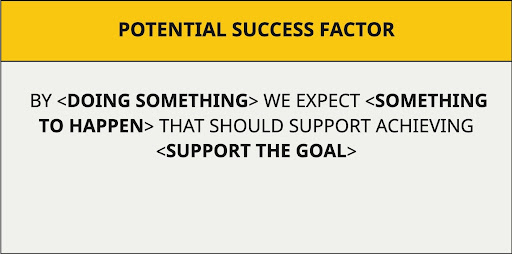
Step 4: Classify your projects and/or tasks as Necessary Conditions or Experiments depending on the Success Factors
To be able to leverage a CSF we need to maintain and continuously evolve it. This requires a CSF always has at least one Necessary Condition (NC). The NC will bring the strategy to a tactical level and allow operational work to start. NCs can act as an anticipatory trigger, reacting to or prompting specific events/needs. For example, we could periodically review a policy to check how it’s performing against some Key Performance Indicators (KPIs).
We may express a Necessary Condition in the following form:
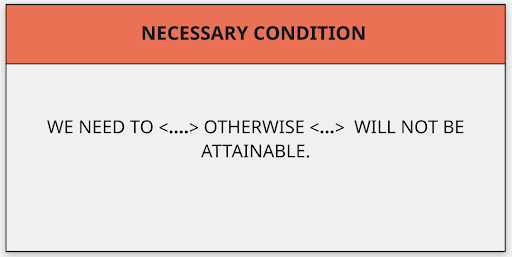
Experiments are our way to decrease the unknowns of our hypothesis, so we can validate or invalidate them as fast as possible, empirically, and without relying on assumptions that ultimately increase risk. Experiments also help prioritize and identify dependencies. They may need NCs as the prerequisite elements to start the Experiments. To get quick feedback and make decisions, the recommended duration of an experiment should be between four and 12 weeks. While, in Cynefin terms, experiments in the Complicated domain should evaluate identified options, experiments in the Complex domain aims at identifying potential options.
A practical example of combining OKRs with The Agile Strategy Map™
Let’s put all that theoretical knowledge into a more concrete example.
As the “Space Tourists Inc.” you have the company vision “Be the leader of the space tourism market.” During your annual planning meeting, you have decided to increase your share of space tourism as part of your Q1 goal.
Example Key Results
After some conversations with your team members and management, you picked two Key Results to focus on:
- Increase sign-ups for Mars travel by 30% (which you know will increase your share in the market)
- Increasing the returning travelers by 20% (which you hypothesize can help to increase your share in the market)
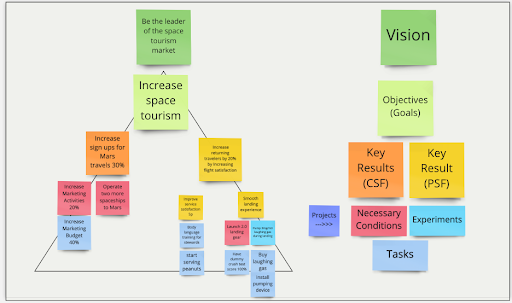
Example CSFs and PSFs
In this example, you have one CSFs and one PSF.
Unpacking the CSF
We learned that “increasing sign-ups for Mars travel” can help us to achieve our goal of “increasing our share in the space tourism market”. We can measure it with the “number of the tickets sold to Mars.”
- Increasing sign-ups for Mars travel by 30% comes with two Necessary Conditions
- We need to increase the Marketing Activities by 20%; otherwise, we can’t reach enough people to create Mars’ travel demand
- We need to operate two more spaceships to Mars; otherwise, we can’t meet the demand
Although you’ve got some clear plans and conditions for increasing sign-ups, you aren’t sure if increasing the returning travelers will expand your market share. If there are more returning travelers, your market share will be higher if these returning travellers book more flights through you, and do not go through a competitor.
In order to increase the number of the returning customers, you want to start with increasing the flight satisfaction. It makes sense to have this as a Key Result because your previous experiments validated that people tend to fly with you more than once if they enjoyed the experience.
Unpacking the PSF
By improving our flight satisfaction, we expect that more people will sign up for a second flight as returning travelers (and don’t prefer a competitor), which should support achieving our goal of increasing the space tourism market share.
Your hypotheses are, “if we can increase your flight service satisfaction and improve the landing experience, this will positively impact the returning customer rate.”
For each different hypothesis, you can create separate PSFs.
Let’s start with the following piece of the puzzle: “by improving our in-flight service satisfaction…” If you achieve this, you expect that people will want to fly with you more often, which should support achieving your goal of increasing your market share in space tourism. We will measure this with an improved flight satisfaction survey.
Next, we’ll look at the “improve our landing experience” part. If you achieve this, you can expect that people will want to fly with you more often, which should support your goal of increasing your market share in space tourism. We can also measure this with an improved flight satisfaction survey.
Unpacking the Necessary Conditions and Experiments
Landing experience is strictly tied to one Necessary Condition, “Launching Landing Gear 2.0,” and one experiment, “Distribute laughing gas during landing.”
- We need to launch Landing Gear 2.0; otherwise, we’ll keep having hard bumps, which increases significantly the risk of injuring passengers
- To complete Landing Gear 2.0, we have to complete dummy-crash tests and score 100 points from the NASA evaluation.
As for the experiment:
- We need to distribute laughing gas inside our crafts during landing to foster positive memories. If we don’t, we won’t be able to positively influence the memories of our customers.
- To start experimenting, we need to buy laughing gas, buy a distribution device, and install the device in our crafts.
This example sums up the interpretation of OKRs together with the Agile Strategy Map. In that way, you can define your Objectives and Key Results with more clarity and confidence.
Want a guided free demo of the Agile Strategy Map™?
Our experienced coaches are happy to talk you through this software and how it can supercharge your goals. You can read more about the Agile Strategy Map™ and pricing information, or contact us to book a free demo with our experienced consultants.

